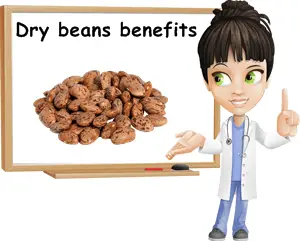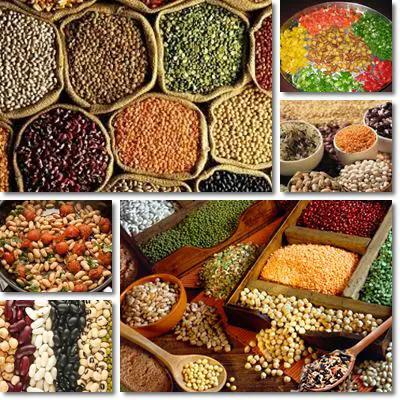Dry beans (Phaseolus vulgaris) are a wonderful source of protein, B vitamins and essential minerals such as potassium, magnesium, phosphorus, molybdenum, selenium and zinc. Regular consumption highly benefits cardiovascular health, improves digestion as well as regulates blood glucose levels and prevents cellular oxidation stress.
While dry beans may not be the poshest culinary choice, they are a reliable and nutritious food that is definitely worth considering for a balanced diet plan.
Dry beans are rich in essential nutrients and antioxidant phenolic phytochemicals with a wide range of important health benefits. Even more, they are quite a versatile food and can be successfully paired with a variety of other foods. What do beans look like when they grow? Beans are the fruit of the bean plant, a stalk in the Fabaceae legume family. The bean plant is grown from seeds (mature beans) and is characterized by a weak green stem that climbs or twines other plants, trees, fences, poles or other supports put at its disposal.
Some varieties however are not vines, but rather take on a bush form.

What do beans look like?
Beans have green, smooth, broad, oval leaves and bear white, purple or pink small flowers. They bear fruit called pods, which also differ in color depending on the variety. Common pod colors include green, yellow and mottled (yellow with purple, for example). Each pod contains about 5-6 seeds called beans which also vary in color from green when unripe to white, yellow, pink, red, black and mottled (usually light brown blotched with darker reddish brown spots).
Beans are 1-2 cm long, kidney-shaped, hard seeds with a tiny white blotch on the concave side.
The unripe fruit are harvested while the pods are still green and tender and consumed together with their pods. They are known as green beans or string beans and require a shorter cooking time (see the benefits of green beans). The ripe fruit, known simply as beans or dry beans, need to be cooked for extensive periods of time (1-4 hours), though cooking time can be reduced by using techniques such as overnight soaking and cooking with the lid on.
What do beans taste like?
Cooked beans have a soft, creamy texture and a mild nutty flavor that goes well with almost anything, from tuna fish and spinach to pork, tortillas and polenta. A wide range of culinary herbs compliment beans, from sweet and spicy paprika and pickled hot peppers to oregano, thyme, parsley and especially celery stalks, celeriac and lovage (see the benefits of lovage).
Beans are a surprisingly nutritious food, rich in essential vitamins and dietary minerals, not to mention a great source of protein, dietary fiber, carbohydrates and antioxidants, all of which contribute to their health benefits. Read below and find out the 9 reasons why beans are a healthy staple in your diet.

What are the benefits of eating beans?
Great source of protein
Only 100 g of dry beans supply us with about 20 g of quality protein required for keeping in good health. Having enough protein in your diet not only helps you lose weight and build muscle mass, but also improves hair and nail appearance, blood and bone health and contributes to enzyme and hormone formation. Medical experts recommend getting most of our protein intake from legumes such as beans, nuts, whole grains, fish as well as from poultry and eggs.
Rich in dietary fiber
Depending on the variety, beans provide us with 15-20 g of dietary fiber for every 100 g. Dietary fiber holds many benefits, the most noteworthy being weight loss, digestive health, colon and cardiovascular health and relieve constipation.
Lower cholesterol and support heart health
Beans contain generous amounts of dietary fiber which binds to part of the fat in the foods we eat. Instead of our intestines absorbing it, it is expelled from our body along with our bowel movements which indirectly contributes to lowering LDL (bad) cholesterol and triglyceride levels. In addition to this, beans provide good amounts of potassium and magnesium, two heart-friendly dietary minerals which regulate blood pressure and contribute to maintaining the health of the heart muscle.
Aids digestion
Legumes such as beans (peas, chickpeas, lentils) are prebiotics, natural compounds that feed our gut bacteria. Prebiotics basically provide sustenance for our gut flora, contributing to digestive health. Gut bacteria are also important because they help synthesize essential nutrients such as B vitamins and vitamin K. Having a healthy gut flora reduces one’s chances of malabsorption problems and nutrient deficiencies.
Excellent B vitamins and iron source
Beans are often recommended as a meat substitute to people having a high red meat intake, heart sufferers and people leading a vegetarian or vegan lifestyle as they contain generous amounts of B vitamins and iron (8-18 mg). B vitamins are essential for digestive health, while iron is pivotal for red blood cell formation, making beans a great option for anemia sufferers as well.
Boast a low glycemic index and anti-diabetic benefits
According to www.health.harvard.edu, beans have a low glycemic index (30). This basically means that your body will absorb the carbohydrates in beans more slowly which will have little to no effect on your blood sugar and insulin levels. In other words, beans help stabilize blood sugar levels and may prove a useful food both for diabetes management and prevention.
Good for bone health
Beans may contain 300 to 488 mg of phosphorus per 100 g, making them ideal for bone and nerve health. Phosphorus is an important component of nervous tissue, cell membranes, RNA and DNA.
Good food for losing weight
Beans promote weight loss when part of an overall balanced diet. Eating beans instead of processed foods, pairing them with lean meat and vegetables or ditching white flour products for them may indeed help slim you down. Their high dietary fiber content means they help limit the amount of fat you absorb from the foods you eat and you feel full for longer, while their high protein content means they help your body start burning fat deposits.
Anticancer properties
Beans have been found to contain isoflavones, plant compounds believed to help prevent various forms of cancer such as colon cancer. However, such benefits may also be owed to the fact that beans encourage a shorter transit time and feed gut bacteria, supporting an overall healthy and balanced gut ecosystem.
See also : Can You Freeze Uncooked Beans?
What are the side effects of Beans?
Unfortunately, there are a few downsides to bean consumption. Eating too many servings may cause gas, bloating and flatulence, loose stools, diarrhea, stomach cramps. On the one hand, this may be due to the fact that humans lack an anti-oligosaccharide enzyme to properly digest the oligosaccharides in beans. On the other hand, the gastrointestinal manifestations may be a result of the legume’s high fiber content.
Having an inflammatory bowel condition such as IBS, irritable bowel syndrome, or even gastritis is more likely to cause digestive upset with symptoms such as bloating, cramps and discomfort, loose stools and diarrhea. Also, beans may contain antinutrients which can reduce the absorption of nutrients such as vitamins and dietary minerals.
Not cooking beans well leaves them unsuitable for human consumption due to them containing phytohaemagglutinin, a lectin which may prove toxic for humans and monogastric animals. So don’t feed your hamster raw beans, dried beans, undercooked beans or lentils for that matter. Other than that, keeping to a moderate intake, in accordance to your nutritional requirements, should be highly beneficial for you.
